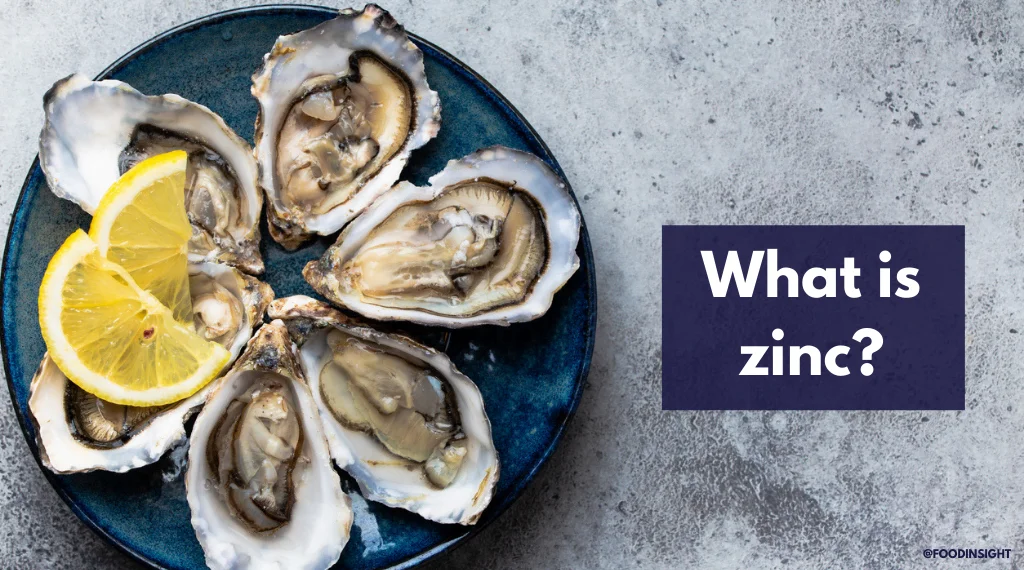
Highlights
- Zinc is an essential mineral that is involved in the body’s immune function, growth, development, wound healing and cell production.
- Zinc deficiency can lead to stunted growth in children and adolescents, as well as fertility issues, skin irritation, susceptibility to infection and slow wound healing.
- Zinc in our food supply is found mostly in animal-based proteins, although it can also be found in plant-derived foods, dietary supplements and throat lozenges.
The basics
Zinc is a mineral that plays a diverse array of roles in human health. It’s a necessary component for much of the activity within our cells, including DNA and protein synthesis. It also supports the body’s immune function, growth, development and wound healing. Because minerals cannot be produced by the body, it is important that zinc is adequately obtained from our diet. Zinc is found in a variety of animal and plant-based foods and can also be found as a stand-alone dietary supplement and as an ingredient in throat lozenges intended to reduce symptoms of the common cold.
Although deficiency is relatively rare in developed countries, certain populations are at risk for not consuming enough zinc, which can manifest as stunted growth in children and adolescents, fertility issues, diarrhea, skin irritability, increased risk for infectious diseases and slow wound recovery. Several groups are at risk for deficiency, including people who are malnourished or have difficulty absorbing nutrients from the gastrointestinal tract (such as people with inflammatory bowel disease or celiac disease), pregnant and breastfeeding women, vegetarians and vegans, and people who abuse alcohol.
Zinc supplementation has also been associated with reducing the duration of the common cold, although these effects can vary from person to person and an optimal dose of zinc has not been determined.
Zinc and health
Zinc is crucial for the proper functioning of many body systems and cellular processes, including:
- DNA and protein synthesis. Zinc is a component of several enzymes involved in creating DNA and proteins, and also stabilizes DNA’s structure.
- Immune function. While zinc’s role in immune function is not fully understood, it is known to be involved in the development and functioning of immune cells, which are needed to fend off infection and inflammation.
- Growth and development. Zinc is necessary for cell production, and therefore contributes to the body’s proper growth and development. Children who are deficient in zinc may show signs of impaired growth.
- Wound healing. Zinc accelerates the healing process of wounds and burns due to its role in the synthesis of collagen, which is an important protein found in skin. Zinc is also involved in immune function and generating new, healthy cells and tissues, both of which are necessary functions for wound healing.
Recommended intakes
Our bodies cannot make or store zinc, so it is critical that we get it from our food on a consistent basis. The National Academies of Sciences, Engineering and Medicine have set dietary reference intakes (DRIs) for zinc, and these recommended dietary allowances (RDAs) differ by age, sex and life stage. Teenage and adult men generally have higher zinc requirements as compared with women of the same age; however, women who are pregnant or lactating have an increased need for zinc to ensure the proper growth and development of the infant and support the mother’s health. There is not enough available research to support an RDA for infants ages 0–6 months, so an Adequate Intake (AI) has been set based on the amount of zinc commonly found in human breast milk.
Recommended Dietary Allowances (RDAs) for Zinc (milligrams (mg)/day)
| Age | Male | Female | Pregnancy | Lactation |
| 0–6 months | 2 mg* | 2 mg* | ||
| 7–12 months | 3 mg | 3 mg | ||
| 1–3 years | 3 mg | 3 mg | ||
| 4–8 years | 5 mg | 5 mg | ||
| 9–13 years | 8 mg | 8 mg | ||
| 14–18 years | 11 mg | 9 mg | 12 mg | 13 mg |
| 19+ years | 11 mg | 8 mg | 11 mg | 12 mg |
*Adequate Intake (AI)
Source: The Health and Medicine Division of the National Academies of Sciences, Engineering and Medicine
Tolerable upper intake levels (ULs) have also been established for zinc, because it is possible to consume too much of this mineral. This condition is most common in people who take zinc supplements or who frequently consume throat lozenges containing zinc; in contrast, overconsuming zinc is rare in people who consume large quantities of zinc-containing foods. High zinc intake can cause nausea, vomiting, diarrhea, abdominal cramps and headache. Consistently consuming more zinc than is recommended can also lead to copper deficiency and may impact the effectiveness of certain antibiotics. Zinc-containing nasal sprays or gels intended for use in treating cold symptoms are not recommended, as they have been connected to a loss of the sense of smell.
Tolerable Upper Intake Levels (ULs) for Zinc (mg/day)
| Age | Male | Female | Pregnancy | Lactation |
| 0–6 months | 4 mg | 4 mg | ||
| 7–12 months | 5 mg | 5 mg | ||
| 1–3 years | 7 mg | 7 mg | ||
| 4–8 years | 12 mg | 12 mg | ||
| 9–13 years | 23 mg | 23 mg | ||
| 14–18 years | 34 mg | 34 mg | 34 mg | 34 mg |
| 19+ years | 40 mg | 40 mg | 40 mg | 40 mg |
Source: The Health and Medicine Division of the National Academies of Sciences, Engineering and Medicine
Food sources
Zinc is found naturally in a variety of animal and plant-based foods. It can also be added to some foods and is available as a dietary supplement. Bread, breakfast cereals and other grains are examples of food items fortified with zinc. Certain types of seafood like oysters, crab and lobster are particularly high in zinc, but red meat and poultry are the highest contributors to zinc intake in the United States since they’re more commonly consumed. Vegetarian and vegan diets may be low in zinc due to their lack of animal protein. In addition, phytates, which are naturally occurring compounds present in plant-derived foods like legumes, grains, and vegetables, may restrict zinc’s bioavailability. Therefore, more zinc-rich food sources should be included in vegan and vegetarian diets.
| Food | Serving Size | Zinc Content (mg) |
| Oysters, steamed | 3 ounces | 66 |
| Beef, braised | 3 ounces | 7 |
| Alaskan king crab, cooked | 3 ounces | 6.5 |
| Chicken, dark meat | 3 ounces | 2.4 |
| Pumpkin seeds, dried | 1 ounce | 2.2 |
| Cashews, dry roasted | 1 ounce | 1.6 |
| Yogurt, low-fat | 1 6-ounce container | 1.5 |
| Kidney beans, canned | ½ cup | 1.1 |
| Oatmeal, instant, plain | 1 packet | 1.1 |
| Green peas, cooked | ½ cup | 0.5 |




